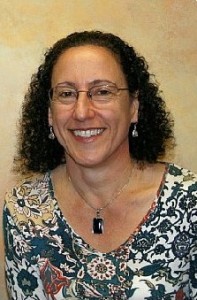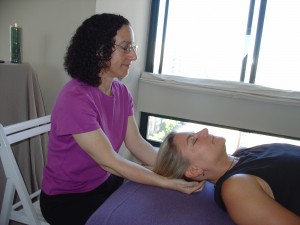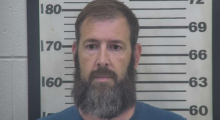Today SevenPonds speaks with Christine Brusati from Sage Hands, a massage therapy service based in San Francisco and Marin. A massage practitioner since 2005, she first studied at both World School of Massage and the Holistic Healing Arts and Diamond Light School of Massage and Healing Arts, and then went on to graduate from the Integrative Medicine Education Program at CPMC’s Institute for Health & Healing, where she gained experience applying skilled touch in a hospital setting. Her other skills include a variety of therapies, such as Swedish, Deep Tissue and Craniosacral massage, as well as Reiki, energy healing and certification in Degriefing: Integrative Grief Therapy. Today, she shares her experiences with integrative massage therapy.
Christopher: What is integrative massage therapy?
Christine: Integrative massage therapy is about helping to balance nervous system. We live in such a stressful world now; our nervous systems are on overload, which means the sympathetic nervous system in the flight or flight response. Massage and integrative therapies help to reset the parasympathetic nervous system, bringing the client or patient back to a sense of calm. Integrative massage therapy draws upon various modalities to serve the needs of the patient or client. It can include anything such as music, guided imagery, yoga, Swedish massage, chair massage, Reiki, breathing techniques and so on. The point is to integrate whatever works for the individual—whatever helps them feel good and want to take care of their body.
Christopher: What modalities do you specialize in?
Christine: In the past, I’ve done primarily Swedish massage, Craniosacral massage, and energy healing. I also do Degriefing®—a holistic approach to healing grief-related pain through the use of verbal and physical techniques. It helps a person identify the parts of heir body where they hold emotional distress and physical discomfort. These days I do mostly energy work and Reiki, which is less intrusive for people. Reiki involves passive hands-on touch and is a wonderful way to realign the endocrine system. It’s especially good for people with Alzheimer’s or those with compromised immune systems because it’s so gentle.
The point is to integrate whatever works for the individual—whatever helps them feel good and want to take care of their body.
Chrisotpher: What is Craniosacral massage?
Christine: Craniosacral massage involves working with the cerebrospinal fluid that runs up and down spine, from the sacrum to the cranium, and tuning into various listening points to follow the rhythm of the fluid. The practitioner uses very light forces and tractions – about 5 grams of pressure. One technique used is call ‘stillpoint’ where you follow the craniosacral rhythm until it reaches its endpoint and create a barrier to stop the flow. You feel the fluid build up and then release. It’s a different way to reset the nervous system. Many people prefer it to having their muscle tissue manipulated.
Sometimes people fall asleep, which means I’m doing my job. They say, “I went to this deep place and feelings came up” – Craniosacral massage can help go deeper into their body, where they may store trauma, emotional pain, grief or loss. “You got issues in your tissues,” we say.
Christopher: Earlier you distinguished between clients and patients. What’s the difference?
Christine: When I was working in the hospital for a year, I referred to people as patients. In my private practice, they’re clients. The difference is the setting and my role there. In the hospital I provided service through the integrative medicine program, where they were patients that I saw, not clients who came to see me on a regular basis in my office.
Craniosacral massage can help go deeper into their body, where store trauma. “You got issues in your tissues,” we say.
Christopher: Your website says you seek “through intuitive touch to connect body and spirit and to create a safe environment rich in healing energy.” What’s it like trying to create this environment in the hospital vs. the home?
Christine: The hospital often treats only the part of a patient’s body that’s affected and doesn’t always look at the whole person. That’s what I do. The emphasis is not to ‘fix’, but to sit and listen: it’s about being present with them, meeting them where they are at. In my private practice, I do the same thing, but have a bit more control over the environment. So many factors are out of my control in hospital—other patients, doctors, nurses, machines, background noise etc. You have to be flexible and go with the flow of the hospital staff. In hospice work, sometimes the emphasis is on supporting the family–giving them an hour to go into another room and a have break.
Christine’s facts on the benefits of integrative massage therapy:
- It reduces mental and physical fatigue and stress.
- It brings the body back into balance by calming and resetting the nervous system.
- Receiving a 10 to 15 minute chair massage can help relieve stress.
- Just a fun fact: hugs can instantly boost oxytocin levels. Give a hug for 20 seconds and see how you feel afterwards.
Christopher: Resetting the nervous system seems mostly calming, but is it ever hard or painful for patients or clients, especially those at the end of life?
Christine: It can be. The dying experience is different for every single person, just like birth. The spirit is leaving the body. Some people don’t want to be heavily medicated; some people are ready, have already stopped eating; sometimes people get very agitated, which is when touch becomes helpful if they’re open to it. I once read, “People die the way they live.” Some die very gracefully, some fight to the end. Often I am there to bring comforting touch, though sometimes just being present at the bedside is enough.
The hospital often treats the part of a patient that’s affected and doesn’t always look at the whole person. That’s what I do. The emphasis is not to ‘fix’, but to sit and listen: it’s about being present with them, meeting them where they are at.
It was actually my mother’s death that led me to this work. I’d always been receiving massage but her end of life really affected me—I was there holding her feet and it was an unforgettable experience. After that, I was called to pursue a career as a massage therapist.
Christopher: Is there anything else you would like our readers to know?
Christine: I invite people to explore all the different ways they can nurture and heal themselves, through all types of integrative therapies, including complementary and alternative medicine. It’s important to see yourself not just as isolated parts that need to be treated, but as a whole person—body, mind and spirit.
Christopher: Thank you for speaking with us, Christine.
Christine: Of course!
More from Professional Advice:
- How to Use Touch to Heal From the Loss of a Loved One? An Interview with Travis Sigley
- What Are the Tools for Meditating While Dying? An Interview With Maneesha James
- What is Music Thanatology? An Interview with Sharilyn Cohn

 What is integrative massage therapy? An interview with Christine Brusati
What is integrative massage therapy? An interview with Christine Brusati





 Funeral Home Owner Chris Johnson Spending Halloween in Jail
Funeral Home Owner Chris Johnson Spending Halloween in Jail
 Our Monthly Tip: Toast a Loved One with a Personalized Glass
Our Monthly Tip: Toast a Loved One with a Personalized Glass
 My Cousin’s Death Taught Me the Meaning of Life
My Cousin’s Death Taught Me the Meaning of Life















Thanks for sharing this great interview of Christine Brusati. When massage therapy increases the oxygen level in our blood then we naturally feels better. I hope many massage therapist will gain knowledge form this post. Thanks again.
Report this comment
Thanks David for your thoughts. A good basic principle about your oxygen comment. Interesting how we are looking at things in a deeper sense now.
Report this comment
Very nice post. I just stumbled upon your blog and wanted to say that I have
truly enjoyed surfing around your blog posts. After all I’ll be subscribing to your rss feed and I hope you write again very soon!
Report this comment
Hmm it seems like your blog ate my first comment (it was extremely long) so I guess I’ll just
sum it up what I wrote and say, I’m thorouughly eenjoying your blog.
I too am an aspiring blog blogger but I’m still new to the whole thing.
Do you have any points for beginner blog writers?
I’ddefinitely appreciate it.
Report this comment
Extremely good post. I just discovered your website and wished to say that I have definitely enjoyed surfing
around your blog posts. In any case I’ll be signing up to your feed as well as
I hope you write once more soon!
Report this comment
Hi Austin,
Yes we agree and thanks for such a great compliment! Our bloggers work hard to create such wonderful posts. We hope you will continue to visits us.
Suzette
Report this comment
fantastic submit, very informative. I ponder why the other specialists of this sector do not notice this.
You should continue your writing. I am sure, you’ve a huge readers’ base already!
Report this comment
I do not even know how I ended up here, but I thought this post
was great. I don’t know who you are but certainly you are going to a famous
blogger if you aren’t already 😉 Cheers!
Report this comment
Fastidious response in return of this query with genuine arguments and telling the whole thing about that.
Report this comment
This page definitely has all of the info I wanted concerning this subject and
didn’t know who to ask.
Report this comment
It’s awesome for me to have a site, which is
beneficial designed for my knowledge. thanks admin
Report this comment